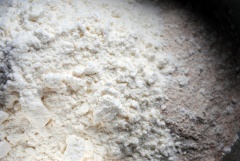Flour
| Infobox on Flour | |
|---|---|
| Example of Flour |  |
| Facts | |
| Origin | |
| Stowage factor (in m3/t) | |
| Humidity / moisture | |
| Ventilation | |
| Risk factors | |
Flour
Description
Flour is a powder which is made by grinding cereal grains, other seeds or roots (like Cassava). It is the main ingredient of bread, which is a staple food for many cultures, making the availability of adequate supplies of flour a major economic and political issue at various times throughout history. Wheat flour is one of the most important foods in European, North American, Middle Eastern, Indian and North African cultures, and is the defining ingredient in most of their styles of breads and pastries.
Maize flour has been important in Mesoamerican cuisine since ancient times, and remains a staple in much of Mexico and parts of Central America.
Rye flour is an important constituent of bread in much of central Europe.
Milling of flour is accomplished by grinding grain between stones or steel wheels. Today, "stone-ground" usually means that the grain has been ground in a mill in which a revolving stone wheel turns over a stationary stone wheel, vertically or horizontally with the grain in between. Many small appliance mills are available, both hand-cranked and electric. The mill stones frequently rub against each other resulting in small stone particles chipping off and getting into flour, but they are removed before the flour is sold.
Rollermills soon replaced stone grist mills as the production of flour has historically driven technological development, as attempts to make gristmills more productive and less labor-intensive led to the watermill and windmill. These terms are now applied more broadly to uses of water and wind power for purposes other than milling. More recently, the Unifine mill, an impact-type mill, was developed in the mid-20th century.
Flour contains a high proportion of starches, which are a subset of complex carbohydrates also known as polysaccharides. The kinds of flour used in cooking include all-purpose flour, self-raising flour, and cake flour including bleached flour. The higher the protein content the harder and stronger the flour, and the more it will produce crusty or chewy breads. The lower the protein the softer the flour, which is better for cakes, cookies, and pie crusts.
Shipment / Storage / Risk factors
Flour is shipped in gunny bags, also frequently in polythene bags enclosed in the usual cotton bags. Should be stowed apart from odorous, wet or oily goods. Liable to take taint, heat and cake when wet. Dampness causes flour to heat and ferment, resulting in an odour which may permeate cargo stowed nearby. Mouldiness and caking may be due to stowage close up to an insulated bulkhead. Flour will always turn mouldy and cake unless stowed well clear from such bulkheads with free ventilation space between.
Lumpiness to flour may arise out of natural causes, without any contact with water. The higher the extraction of flour, i.e. the darker the flour, the greater is the risk of its going lumpy, especially when subjected to a long ocean voyage through tropical climates and when stored for a long period in a hot climate, particularly if under pressure.
Recent contact with water limits the damage to a coating of caked flour, which protects the remaining flour in the bags from water infiltration, and provided the flour is quickly segregated and the caked flour removed, a good portion of the contents may be saved. If this operation is not carried out with the utmost speed the flour not affected by water will be tainted and badly damaged through lack of ventilation.
Flour may also be lost through tearing of bags as a result of careless handling or the eating of part of the bags by rodents. Sweepings are usually collected and replaced in slack bags, provided they are free from dirt and impurities; otherwise sweepings should be separately packed to avoid mixing with sound flour. A musty odour should not be confused with an odour derived from the bag in which the flour is usually packed; such odours are usually removed by proper airing of the flour. Flour is very hygroscopic and will absorb and lose moisture according to the conditions of stowage and storage. If stored in conditions of high humidity the development of mould, bacteria and insect life is accelerated. Such mould and bacteria are dormant in flour and only require certain conditions to cause this dormant life to manifest itself. Such development, however, does not necessarily destroy the flour, which, if properly sifted, is fit for use. Very seriously infected flour, if unfit for human consumption, may be used for other purposes.
When shipped in polythene bags and loaded in cold temperatures, sweating may take place, according to the voyage, while the goods are stowed in vessel’s hold, with the result that the outer covers may be found to be badly stained with green and black mildew, but with the flour unaffected. Stowage in Dry Steel ventilated containers. Containers should be clean, dry and odourless. Preferred stowage should be in a ventilated area, away from heat and infested and odorous cargoes (i.e. hides,
skins, onions etc).











